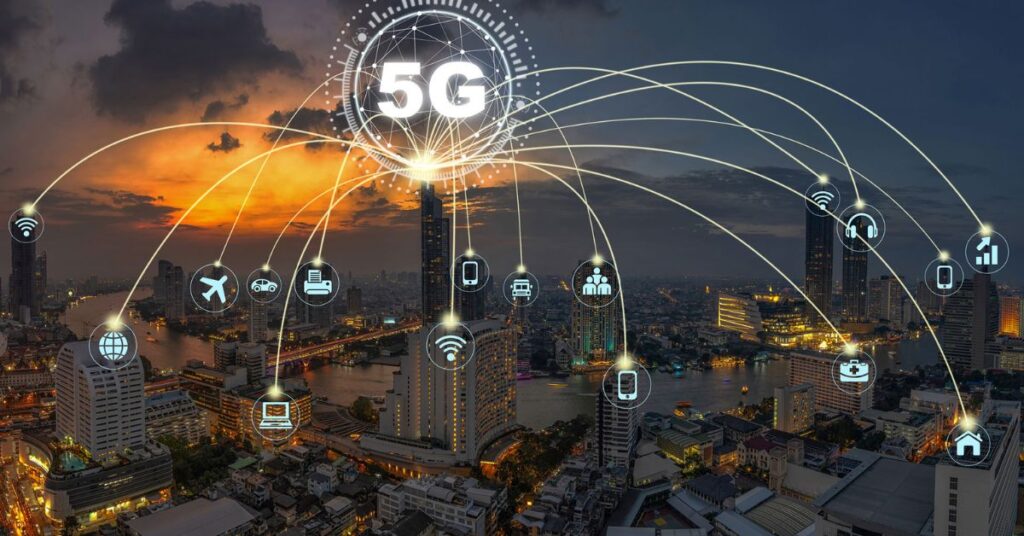5G is reshaping the world with high-speed networks and unparalleled efficiency. From smart cities to surgical robots and remote telehealth, it’s revolutionizing the way we live and work. This article explores the benefits of 5G, its unique features, and its transformative impact.
5G technology is the fifth generation of wireless communication that revolutionizes how we connect and interact. Its key features include ultra-fast speeds, low latency, and massive connectivity. These advancements bring numerous benefits and open doors to exciting new applications.
Imagine downloading a movie in seconds or enabling smart cities with seamless communication. 5G is not just about speed; it’s about unlocking possibilities in healthcare, transportation, and beyond. It’s changing the way we live, work, and innovate.
Understanding 5G: What Sets It Apart?
5G is the fifth generation of mobile connectivity, built to handle data-intensive applications and massive device connections. Unlike its predecessors, it uses 5G mmWave and mid-band spectrum to deliver higher speeds and low latency for seamless communication.
Another standout feature is network slicing, which allows customized virtual networks for specific needs. For instance, industries can create virtual private networks (VPN) for 5G-enabled automation systems while maintaining speed and reliability. This makes 5G versatile, meeting the demands of sectors like healthcare, transportation, and manufacturing.
You May Also Read this Blog:Understanding 5G Technology and Its Transformative Benefits
Why 5G Matters: Key Features and Benefits
The bandwidth advantages of 5G are a game-changer for massive IoT deployments. Connected devices in homes, offices, and factories can now interact without delays. For example, faster communication in factories ensures smoother operations and real-time problem-solving.
Additionally, 5G infrastructure deployment supports high-band mmWave spectrum, enabling applications like remote, real-time collaboration and augmented reality (AR). With enhanced mobile broadband, users enjoy uninterrupted streaming, gaming, and virtual experiences.
Comparing 5G and 4G: The Leap Forward
The difference between 5G speed vs 4G speed is striking. While 4G supports 100 Mbps, 5G can exceed 10 Gbps under ideal conditions. This leap enables data-intensive applications like vehicle-to-everything (V2X) communication and precision agriculture.
Another advantage is ultra-reliable low latency communications (URLLC). Tasks that were once limited by delays, such as surgical robots and remote telehealth, are now possible. This reliability also supports connected cars and hospitals, enhancing safety and efficiency.
| Feature | 4G | 5G |
| Speed | 100 Mbps | 10+ Gbps |
| Latency | 50 ms | <1 ms |
| Devices Supported | 10,000/sq km | 1,000,000/sq km |
| Bandwidth | Limited | Expansive |
Real-World Applications of 5G

Smart city street lighting is a prime example of 5G’s impact. Sensors powered by massive IoT deployments optimize energy use and improve public safety. Similarly, advanced public transit systems rely on 5G-enabled automation systems for real-time updates and efficiency.
In healthcare, telemedicine and surgical robots enhance access to care. Rural areas can now connect to specialists through remote, real-time collaboration, bridging gaps in healthcare delivery. This innovation is transforming lives, one connection at a time.
5G Ultra Wideband: What You Need to Know
5G Ultra Wideband stands out for its higher capacity and faster speeds compared to standard 5G. Using the mid-band spectrum, it delivers reliable service even in dense urban areas.
Industries like manufacturing benefit from 5G and manufacturing automation, enabling precision and efficiency. Companies like Digi International 5G solutions provide tools to unlock the full potential of 5G infrastructure deployment.
The Future of 5G: A New Era of Connectivity

By 2028, 5G adoption is expected to skyrocket, shaping a world of smarter, more connected systems. Technologies like edge computing will work alongside 5G, enabling faster decision-making in critical applications.
Looking ahead, the rise of LTE-M and NB-IoT alternatives ensures that all devices, from connected cars and hospitals to precision agriculture tools, have seamless connectivity. This new era will redefine how we interact with the digital world.
Ready to Embrace 5G?
For USA consumers, adopting 5G is simple. Start by checking 5G infrastructure deployment in your area and upgrading to compatible devices. Choose a carrier offering high-speed networks and mobile broadband tailored to your needs.
The potential of 5G is limitless, from mission-critical applications to everyday conveniences. Embrace this transformative technology and join the future of connectivity today.
FAQ’s
How Does 5G Work?
5G uses advanced technologies like 5G mmWave, low latency, and network slicing to provide faster, more reliable wireless communication by leveraging higher frequencies and smarter infrastructure.
Where Is 5G Available?
5G is available in major cities across the USA, with ongoing 5G infrastructure deployment aiming to expand coverage into rural and suburban areas by 2028.
Is 5G Home Internet Better Than Cable?
5G offers higher speeds and lower latency compared to traditional cable but may cost more depending on location and provider.
Is 5G Business Internet a Good Investment?
Yes, 5G-enabled automation systems and remote, real-time collaboration make it invaluable for enterprises needing fast, reliable, and scalable connectivity.
Conclusion
The Future of Connectivity: Key Features, Benefits, and Applications of 5G Technology is reshaping industries and personal lives alike. With its high-speed networks, low latency, and ability to support massive IoT deployments, 5G is unlocking possibilities we once only imagined. From connected devices to surgical robots and remote telehealth, it’s laying the foundation for smarter, more efficient systems.
As 5G adoption continues to grow, its influence will span sectors like healthcare, transportation, and agriculture, revolutionizing how we interact with technology. Whether through smart cities or 5G-enabled automation systems, this innovative technology is creating a seamless and connected world. Embracing 5G isn’t just about faster speeds; it’s about stepping into the future of connectivity and transforming the way we live and work.







